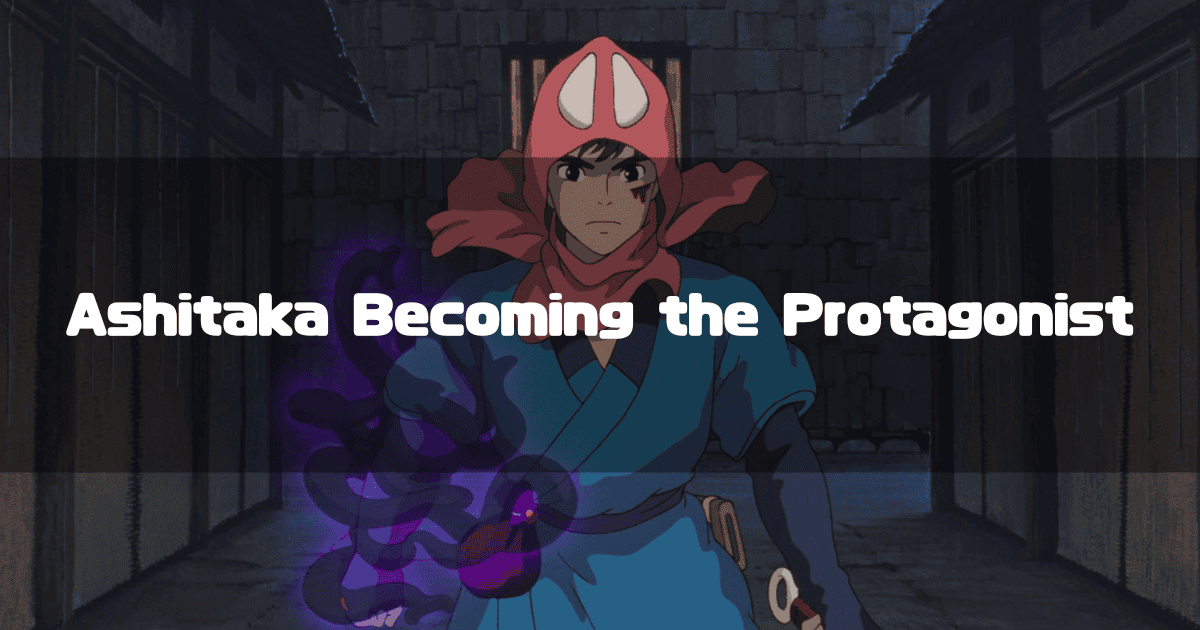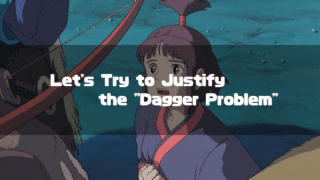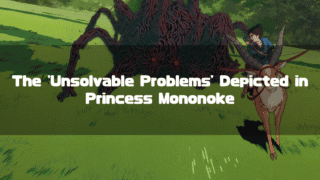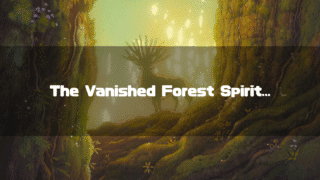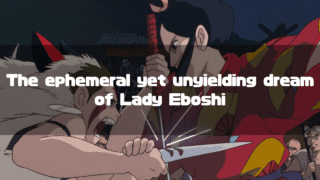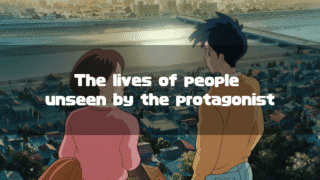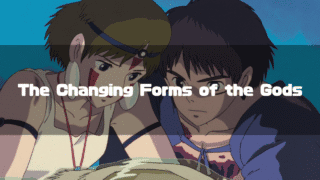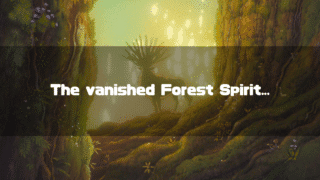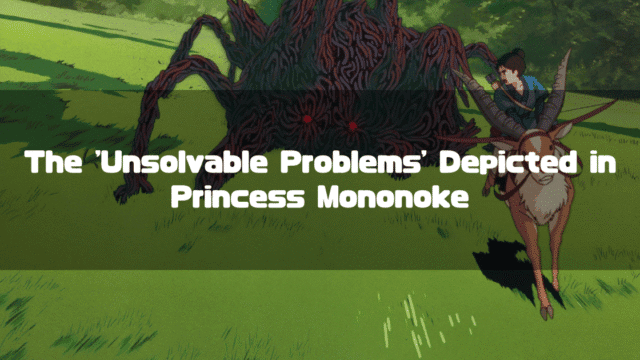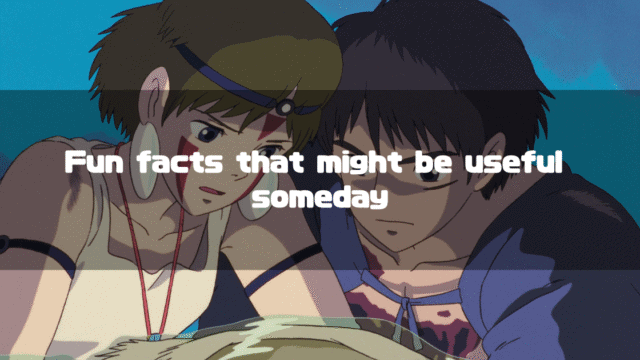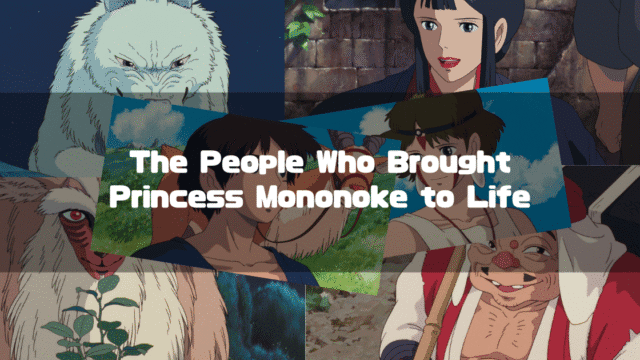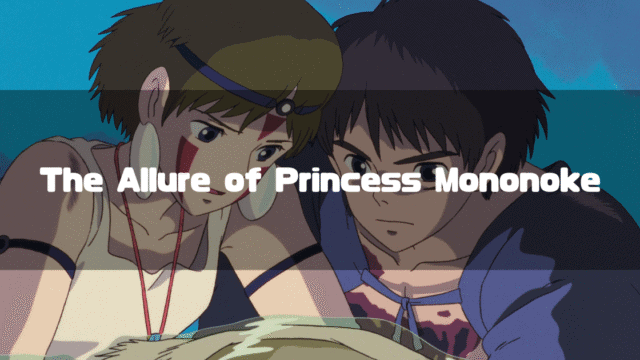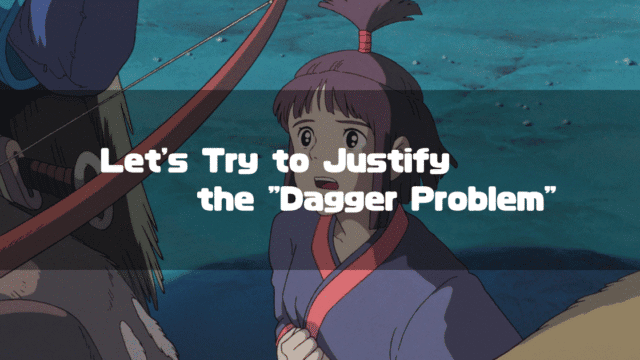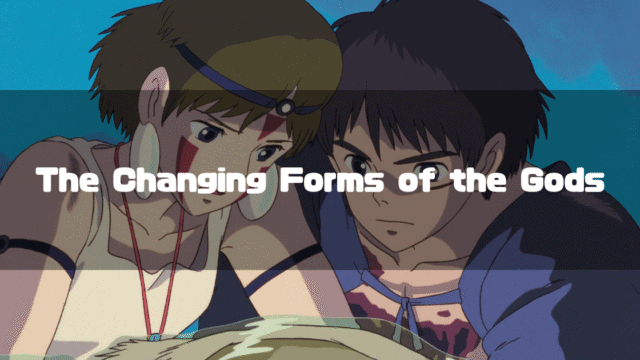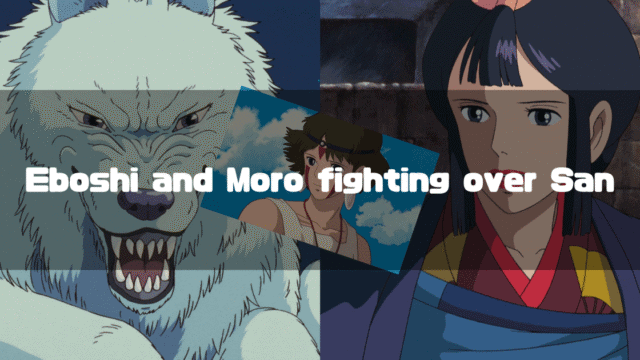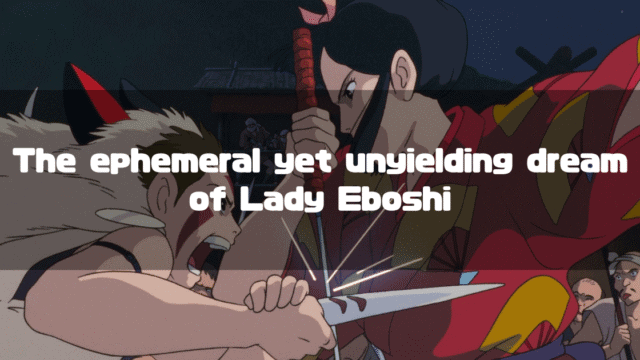Princess Mononoke(Studio Ghibli Official) is a feature-length animated film directed by Hayao Miyazaki, released in 1997.
This time, I’d like to think about one of its characters, Ashitaka. I will particularly focus on the aspect of Ashitaka as the “protagonist.”
While opinions may be divided on who the protagonist of Princess Mononoke is, I personally believe it is Ashitaka. This can be inferred from the title Hayao Miyazaki was considering, Ashitaka Sekki (“Sekki” is a word coined by the director, meaning a story passed down by word of mouth, buried in the grass). Beyond that, looking at Ashitaka’s portrayal in the film, it’s clear that Ashitaka has distinct differences from the other characters.
This time, I will discuss “Ashitaka as the protagonist” by examining the differences between Ashitaka and the other characters.
First, let’s look back at the characters other than Ashitaka, the “protagonist.” They are “people who hide their true feelings” (this includes Ashitaka at the beginning).
*This article is an English translation of the original Japanese article, 【もののけ姫】「主人公」としてのアシタカと本音をひた隠す人々.
Let an AI walk you through the highlights of this post in a simple, conversational style.
- Jiko-b?, Lady Eboshi, San, Moro, and the people of Irontown all lived while hiding their true feelings.
Jiko-b? hid his mission, Eboshi never spoke of her past and ambitions, San denied her awareness of being human, Moro couldn’t bring herself to completely hate humans, and the people of Irontown hid their suffering with expressionless faces. - Ashitaka also initially hid his own sorrow and despair.
Ashitaka, who left on his journey with a smile, not showing the sadness of being exiled from his home or the fear of the curse, was also a being who suppressed his true feelings at first. - Ashitaka becomes the protagonist by becoming “one who controls hatred.”
By overcoming his own hatred, being able to declare to others “Do not be consumed by hatred,” and by the tears he shed after learning the Forest Spirit did not save him, he was completed as a “protagonist” who lives for others. - Ashitaka creates a “wavering” in people’s hearts as “one who speaks his mind bluntly.”
He touches upon the true feelings that those around him hide, simultaneously evoking “admiration” and “anger,” and plays the role of a “liberator” who prompts people to reconsider. - Ashitaka’s “tactless remarks” are the reason he is the protagonist.
His attitude of speaking ideals without considering others’ circumstances is what drives the story, moves people’s hearts, and becomes the driving force that guides the story as the “protagonist.” It was also a major factor in being accepted by San and Moro.
The People Who Hide Their True Feelings in Princess Mononoke
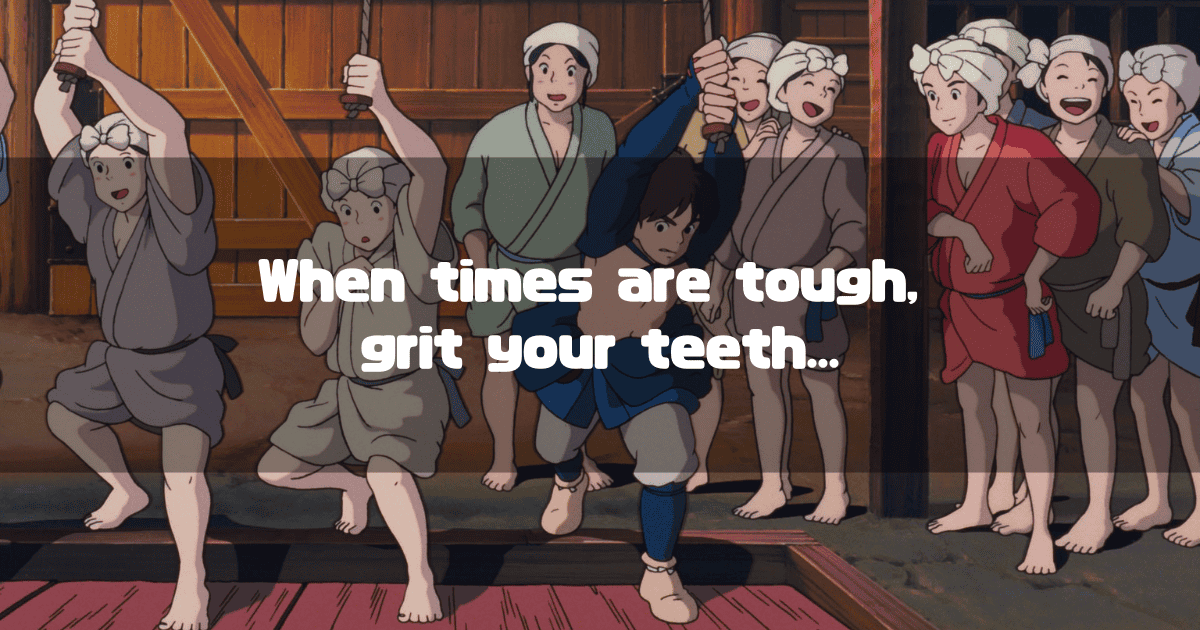
The Devious Jiko-b?
In Princess Mononoke, the first character to clearly hide his true intentions was probably Jiko-b?.
Jiko-b? must have grasped the entire situation when Ashitaka showed him the lead ball from the hand cannon. However, he said nothing in particular about the ball, only reacting to Ashitaka’s mention of a “giant boar” and informing him of the existence of the “Forest of the Forest Spirit.”
Speculating on Jiko-b?’s inner thoughts at this time, it might be something like:
- I want to give him information since he’s my savior, but
- I don’t want to tell him anything related to my “job,” and
- Talking about the hand cannon would give a bad impression of me.
In any case, it is clear that he is a person who does not tell everything he knows.
Lady Eboshi with a Painful Past
Lady Eboshi, a central figure in Princess Mononoke, is also someone who completely hid her true inner self.
It’s not apparent just from watching the film, but Lady Eboshi has a painful past of being “sold overseas and forced to be the wife of a Wak? (Japanese pirate) chieftain” (Reference: How Princess Mononoke Was Born(「もののけ姫」はこうして生まれた, in Japanese)”). Lady Eboshi distinguished herself in that environment, eventually took revenge on the chieftain, and returned to Japan with her subordinate at the time, Gonza.
This is a fact that cannot be known just by watching the main story, and Lady Eboshi probably doesn’t go around telling people about it.
The inner truth that Lady Eboshi hides is an intense desire for revenge against the world itself (the world created by men) that forced such a harsh life upon her.
This desire for revenge is not mentioned by her in the main story, but a leper in Lady Eboshi’s “secret garden” said the following:
“Watch out. Lady Eboshi wants to rule the country”
This line is delivered in a very joking manner, and even watching the main story, the improvement of the hand cannons seems only to be “to increase the self-defense capabilities of Irontown.”
However, this leper’s line probably speaks for Lady Eboshi’s true feelings. One piece of evidence is that Eboshi herself does not react at all to this lighthearted remark.
To summarize, the inner truths that Lady Eboshi did not show were:
- The suffering of her past,
- Her ambition to turn this world upside down.
This is what it comes down to.
San, Who Continues to Deny Herself
Compared to Jiko-b? and Lady Eboshi, it might seem that San has no hidden inner secrets, but in my eyes, she did have hidden true feelings.
Basically, there are no contradictions in San’s words and actions, and she simply appears to be a person who “attacks humans who destroy nature.”
The details of San’s origins are unknown, but Moro puts it this way:
“The humans who violated the forest threw her in my path as they ran from me.”
Under these circumstances, it seems natural for San, raised by Moro, to oppose humans as one of the “forest people.” However, San’s self-awareness that “I am a wolf” seems excessive at times.
If we consider that people tend to act rashly to be what they want to be when they are “not who they want to be,” it would mean that San was more aware than anyone that “she is human.”
On top of that, her natural love for Moro who raised her, and her natural attachment to the forest where she grew up, became the principles of San’s actions, and she sought her identity as a “fundamentalist” “wolf.”
In other words, the sad truth she did not show would be, “the awareness that I am human.”
When I think of it that way, I am struck by the cry of her soul, “I am a wolf!” which San unleashes on Ashitaka after the Forest Spirit goes berserk at the end of the story. The expression “struck by” is rather cliche, though.
Moro, Who Cannot Bring Herself to Hate Humans
San’s adoptive mother, Moro, also seems to be a being who hides her true feelings.
The basis for this can be found in the very fact that she “raised the infant San.”
If Moro truly hated humans from the bottom of her heart, she would not have raised San, who was supposed to be human. Even if San was a baby. Or rather, she should have killed her precisely because she was a baby.
But Moro did not.
In other words, Moro’s conflict with humans is a matter of necessity because her life and the lives of the people involved in “tatara iron manufacturing” are in conflict.
However, in the main story of Princess Mononoke, Moro showed no such sense of “necessity.”
What could be the reason for that? … “San’s existence” would be the reason.
In other words, Moro is fighting humans as an unavoidable conflict of the current situation, but her beloved daughter, San, hates humans regardless of that. In addition, she understands San’s feeling of wanting to be more of a wolf than anyone, despite being born human. Moro is truly San’s parent.
Under such circumstances, Moro’s aggression towards humans had to become clear and straightforward. Moro empathized with her daughter’s fierce feelings.
This might be overthinking it, but Moro may have had a slight hope that the well-raised San would stand between humans and the “forest people.” However, San, who grew up in the forest, made an extreme sense of belonging to them her identity. It was then that Ashitaka appeared. He was exiled from his village and had no place to live, and under these circumstances, he sought a way for humans and the “forest people” to coexist. Moro must have thought he was worth entrusting her daughter to.
The People of Irontown Enduring Harsh Labor
In fact, the people of Irontown, at least the women who worked the bellows (fuigo), are also hiding their true feelings.
In the documentary How Princess Mononoke Was Born, there is a scene where Director Miyazaki points out the following to the animator in charge of this scene:
“think that because it’s tough, you should just draw it as tough, is too simplistic. On the premise that it is tough, and yet… if you ask if a marathon runner makes that kind of face just before collapsing, they endure it… right? A job that you can’t continue unless you grit your teeth like that, if you do it for a long time it becomes painful, but at that time, conversely, when you start to get dazed, you’d become expressionless rather than looking pained.”
(Original Text in Japanese)
「辛いだろうから、辛く書けば良いというのは、あまりにも単純で、辛いということが前提になっている上で、なおかつ・・・マラソン選手がね、倒れる寸前にそういう顔するかって言ったらこらえるから・・・でしょ。そんなに、こう歯を食いしばってこらえてなきゃ続かないような仕事、長時間やってればつらくなるけど、そのときに逆に、もうろうとしてきたら辛いかをするよりも無表情になるだろう。」
In other words, the “banko” women working the bellows (fuigo) continue to work them, no matter how painful it is, without showing it (or unable to show it even if they wanted to).
Working the bellows is harsh labor, but the situation before they came to “Irontown” was much more painful, and their gratitude for being able to make a living is greater. Furthermore, they are probably aware that they are not the only ones in such a difficult situation (people all over the world are suffering in some way).
Considering this, it seems there are two reasons why the people of “Irontown” accepted Ashitaka:
- He saved their ox-herder comrades,
- And the fact that he came to a place like this alone.
The people of “Irontown” are wounded people. That is why they accept the “wounded person” who has arrived there.
And surely, that is what Lady Eboshi did for them.
The Exiled Ashitaka-hiko
The main purpose of this article is to consider Ashitaka as the “protagonist,” and for that purpose, I have been making a comparison with the “people who hide their true feelings” I’ve written about so far. However, in fact, Ashitaka also hid his true feelings.
It may seem a bit contradictory, but Ashitaka was the same as the other people at the beginning, and then went through the process of becoming the “protagonist.”
So, what were the true feelings he hid? It must be “the sadness, suffering, and regret of being exiled from his homeland, and the despair of the curse.”
The famous scene where he completely hid his inner turmoil was when he left his homeland with the words, “I will think of you too, Kaya, always.”
At that time, Ashitaka was in the midst of the fear of death from the curse and the despair of exile. He didn’t know what to do next and was simply heading west. In such a painful situation, he showed a radiant smile to repay the kindness of Kaya, who came to see him off.
The people who appear in Princess Mononoke are people who show their best smiles to others at the most painful times in their lives.
Ashitaka as the “Protagonist”
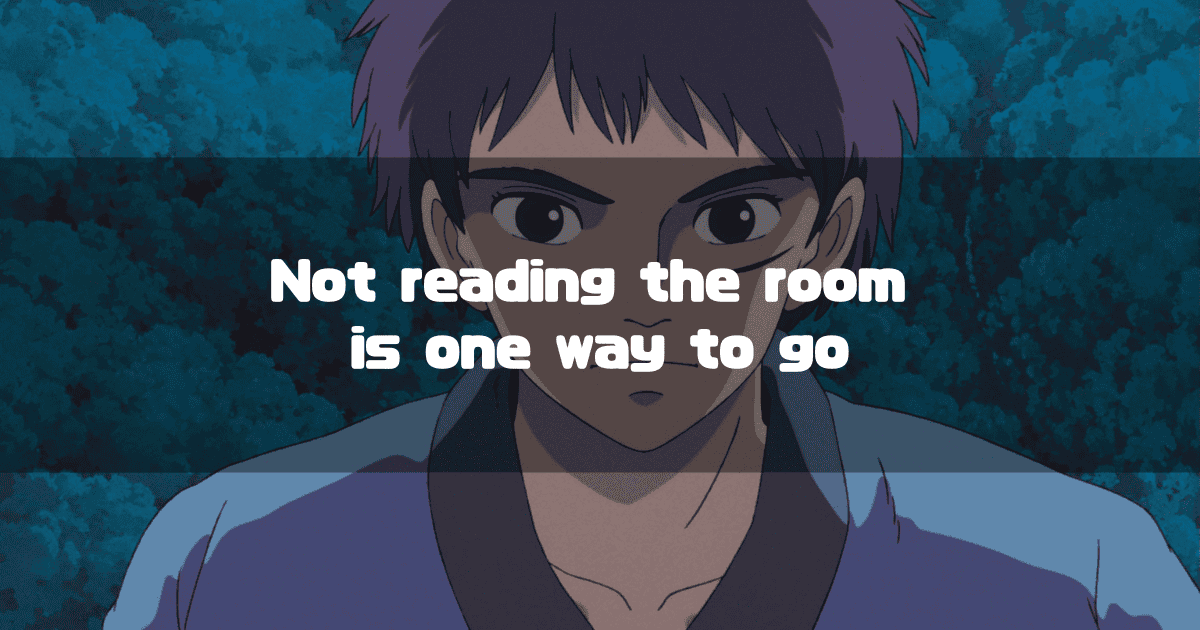
From here, I’d like to consider Ashitaka as the “protagonist.” While the other characters hide their true feelings, Ashitaka is portrayed as a person who splendidly and bluntly says what he wants to say. At first glance, he seems to be just a troublesome person, but through this, Ashitaka becomes the protagonist who liberates people.
First, let’s look back at the stages of him becoming the “protagonist.”
The Two “Paragraphs” for Ashitaka to Become the “Protagonist”
The protagonist of a story is usually decided from the beginning, but in this film, the basic candidates for the protagonist are Ashitaka and San. Looking only at the movie title, it seems like the protagonist is San, but the story begins with Ashitaka’s expulsion from paradise, and it generally proceeds through Ashitaka’s perspective (furthermore, Director Miyazaki was also considering the title Ashitaka Sekki).
Therefore, I think some kind of deciding factor is necessary, and I personally believe that Ashitaka became the protagonist after going through two “paragraphs.”
Those “paragraphs” are, I think:
- The speech he gave while caught between Eboshi and San when San attacked Irontown.
- The tears he shed when he learned that the Forest Spirit did not remove the “cursed mark.”
I believe these are the moments.
By the time San attacks Irontown, Ashitaka’s right arm has gone berserk against his will twice. The first time was the attack with the bow and arrow that ended up saving Jiko-b?. The second time was when he went to the “secret garden” with Lady Eboshi.
However, just before that speech scene, Ashitaka’s right arm does not go berserk.
In other words, Ashitaka has become able to control the “hatred” within himself.
The scenes of Ashitaka’s right arm going berserk are subtly “misleading.” This is mainly due to Lady Eboshi’s line, “Foolish boar. If you must curse someone, curse me.” Since the arm’s rampage begins immediately after this line, it gives the impression that it is due to Nago’s hatred. However, in reality, that rampage should be considered to be due to Ashitaka’s own anger and hatred. Otherwise, there is no explanation for why he was able to control the rampage during San’s attack on Irontown. What he controlled was not Nago’s hatred, but his own hatred. That is why he can insist to the people around him, “Do not be consumed by hatred!”
This alone seems to be enough qualification for a protagonist, but at the time of his speech in Irontown, Ashitaka himself had a big problem. Of course, that is the cursed mark on his right arm.
At that point, Ashitaka must have still held a glimmer of hope that the curse might be lifted.
However, after that, he accepted the fact that the Forest Spirit healed its own wounds but did not lift his curse, and he put an end to his journey to lift his own curse.
This meant that his hope was lost, and out of that sorrow, he shed tears for the only time (and as the only one) in the story.
Ashitaka’s principle of action is fundamentally different before and after these tears. Before, it was a life for himself, and after, it is a life for someone else (especially San).
Ashitaka, who despaired for his own future but decided to live for others, became the protagonist.
Ashitaka’s Role as the “Protagonist”
Now, Ashitaka has decided to “live for others,” but how exactly does one “live for others”?
In the story of Princess Mononoke, it is clear: it means living to free people from “hatred.”
To that end, Ashitaka coolly throws fresh lines at people like “Do not be consumed by hatred!” and “Is there no way for humans and the forest to live together!”
The people who are told this also know it, but they are acting while being trapped by something they cannot resist. To put it another way, they are living with the feeling that “there is no turning back now.”
For such people, Ashitaka’s words might be something they want to dismiss as “a young man’s nonsense,” and yet they also touch a chord in their hearts. The stronger the desire to deny Ashitaka, the greater their “admiration” for Ashitaka’s words.
In other words, they themselves, who react to Ashitaka’s words, also want to shout out their hidden true feelings like Ashitaka.
I think Ashitaka’s role as the protagonist was to create a “wavering” in people’s hearts in this way, making them look at themselves, and ultimately freeing them from “hatred.” Unfortunately, it is hard to say that Ashitaka’s wish came true in the main story, but I think he will continue to do so afterwards. Just as all the “protagonists,” including Ashitaka, have done for us.
Hayao Miyazaki himself has spoken about Ashitaka’s future in various media, somewhat jokingly (for example, in the production documentary How Princess Mononoke Was Born(「もののけ姫」はこうして生まれた, in Japanese)”). Ashitaka decides to live in Irontown, but San does not stop living in the forest. In other words, Ashitaka is destined to be caught between Irontown, which engages in iron manufacturing, and San. He lives earnestly in an infernal situation where if he accepts one side’s argument, the other side cannot stand. It feels a bit pitiful, but from the perspective of “hatred,” it’s not so bad. “Hatred” is a one-sided emotion, and the “wavering” within people is almost the only weapon to erase “hatred.” Ashitaka gave that “wavering” to the people of Irontown and San through his words and actions, but after the main story, Ashitaka is thrown into a “wavering” of physically going back and forth between the forest and Irontown. The way he embodies that “wavering” with his own body is also truly “protagonist-like.”
Appendix: The “Problem Child” Ashitaka
So far, I’ve been thinking about the cool parts of Ashitaka, but if you look closely at the main story of Princess Mononoke, you can also see the “problem child” side of Ashitaka. In the end, it’s that “problem child” part that made him the protagonist, so it’s very well done, but let’s look back on that as well.
Ashitaka, who barges into people’s workplaces.
The scene where Ashitaka first showed his “problem child” side was probably when he went to the place of the “banko” women who were working the bellows (fuigo) in Irontown.
Just before that, the women of Irontown told him to “come and see our workplace,” but normally such words are “social pleasantries” and not a real invitation.
However, Ashitaka not only actually appeared at their workplace but also insisted on being allowed to work the bellows. Ashitaka might have felt that he was helping with the work, but considering they were working under harsh conditions with a strict routine, it was extremely disruptive.
Especially for the person in charge of the place, it was a huge nuisance.
The person in charge there is Toki, and she must have been very troubled by how to respond. She was grateful to him for carrying her husband over a mountain, but she needed him to leave this place as soon as possible.
So, the strategy Toki took was, “let him work the bellows quickly and have him leave immediately.” In this scene, Toki says to the “banko” woman, “Since he’s here, let him take over,” but in fact, the voice recording for this line was redone many times (Reference: How Princess Mononoke Was Born(「もののけ姫」はこうして生まれた, in Japanese)”).
It seems that the kindness and gentleness of the voice actress, Sumi Shimamoto, came out, and the subtle nuance that “Ashitaka is actually a nuisance” did not come through.
In any case, you can see that Ashitaka is a person who cannot think about these things. Although it’s just that he’s “young.”
Ashitaka, who lectures Moro, “She is human!”
Another aspect of Ashitaka’s “problem child” side can be seen in the famous scene from Princess Mononoke where he says, “Set her free! She is human!”
It was an impressive line used in commercials and trailers, and it was probably Ashitaka’s defining scene.
However, if you put yourself in Moro’s position when she was told that, she probably thought, “What are you talking about? I know that. I’ve been thinking for years and years about what to do with her. I’ve even wondered many times if I’m the one holding her back. But she has her own feelings, and we are a family that has lived together. For a complete stranger like you to say ‘Set her free’ is quite something.”
I am impressed by the depth of Moro’s character, who ended this with the reply “Silence, boy!”. I think it was such a “tactless remark” that she could have eaten him for it.
However, this “tactless remark” is extremely important in Princess Mononoke, and it ultimately cuts deep into people’s hearts and makes them stand at the starting line again.
Moro probably felt she could entrust her beloved daughter San to Ashitaka precisely because he coolly declared, “She is human!”
In the end, the quality of “not reading the room” may also be an important characteristic of a “protagonist.” Otherwise, you’re just an “ordinary person.”
I read the room. Yeah.
The above are my personal reasons why Ashitaka is the protagonist and the stages of him becoming one. Looking back, I felt that various elements meshed together brilliantly to make Ashitaka stand out as the protagonist.
What do you all think about the “protagonist” in Ashitaka and Princess Mononoke?
The images used in this article are from “Studio Ghibli Works Stills“.
About the Author
Recent Posts
- 2025-10-21
Indiana Jones and the Dial of Destiny(2023): Full Synopsis & Analysis: Indy’s True Motive and the Enigma of Helena - 2025-10-15
Indiana Jones and the Dial of Destiny(2023):Historical Background-WWII, the Real Dr. Schmidt, the Siege of Syracuse, and the Antikythera Mechanism - 2025-10-08
Why Does Children Who Chase Lost Voices Feel So Ghibli-esque? [Makoto Shinkai’s “Tale of Farewell”] - 2025-10-07
5 Centimeters per Second: Characters, Voice Actors, Character Analysis and Character Map - 2025-10-06
5 Centimeters per Second: Full Synopsis, Analysis, Ending Explained & Character Map (Spoilers)

